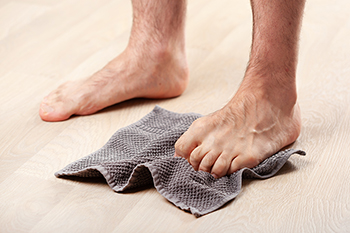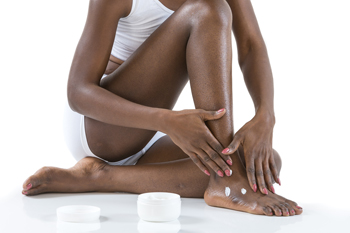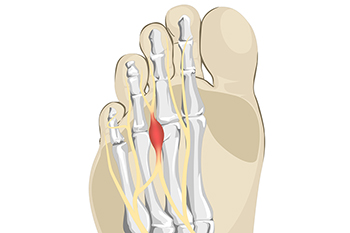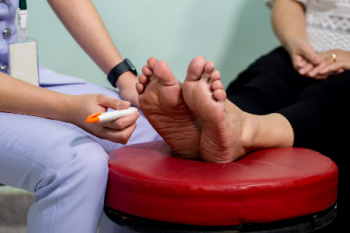Items filtered by date: February 2024
Rehabilitation Exercises for a Broken Toe

Recovering from a broken toe can be a frustrating journey, but with the right exercises, you can expedite the healing process and regain strength and flexibility in your toe. Start with passive toe exercises, where you sit comfortably and use gentle movements to bend your toe forward and backward, gradually increasing flexibility. Toe curls help to strengthen the muscles surrounding the toe, promoting stability and mobility. Towel scrunches provide a great opportunity to work on grip strength and dexterity by using your toes to scrunch a towel towards you and then push it back. Marble pick-ups add a fun and challenging element to your routine as you aim to pick up marbles with your toes and place them into a cup, which improves coordination and control. Lastly, the towel stretch helps to elongate the muscles and tissues in the toe, enhancing flexibility and reducing stiffness. Consistency is key, so aim to incorporate these exercises into your daily routine to support a speedy recovery. If you need help in dealing with a broken toe, it is suggested that you make an appointment with a podiatrist.
A broken toe can be very painful and lead to complications if not properly fixed. If you have any concerns about your feet, contact Gary J. Kaiserman, DPM from Achilles Footcare Center. Our doctor will treat your foot and ankle needs.
What to Know About a Broken Toe
Although most people try to avoid foot trauma such as banging, stubbing, or dropping heavy objects on their feet, the unfortunate fact is that it is a common occurrence. Given the fact that toes are positioned in front of the feet, they typically sustain the brunt of such trauma. When trauma occurs to a toe, the result can be a painful break (fracture).
Symptoms of a Broken Toe
- Throbbing pain
- Swelling
- Bruising on the skin and toenail
- The inability to move the toe
- Toe appears crooked or disfigured
- Tingling or numbness in the toe
Generally, it is best to stay off of the injured toe with the affected foot elevated.
Severe toe fractures may be treated with a splint, cast, and in some cases, minor surgery. Due to its position and the pressure it endures with daily activity, future complications can occur if the big toe is not properly treated.
If you have any questions please feel free to contact our offices located in Forest Lane and West Kiest Boulevard Dallas, TX . We offer the newest diagnostic and treatment technologies for all your foot and ankle needs.
The Significance of Practicing Everyday Foot Care

Practicing everyday foot care is an essential yet often overlooked aspect of overall well-being. The feet, our foundation for mobility, endure daily stresses and strains, making regular foot care a vital practice. By incorporating simple routines into our daily lives, such as washing our feet, moisturizing, and inspecting them for any signs of discomfort or abnormalities, we can prevent common issues like dry skin, fungal infections, and calluses. Wearing proper footwear that provides support and comfort is equally vital, as ill-fitting shoes can lead to a range of problems, from blisters to chronic conditions such as bunions. Regular toenail maintenance helps prevent ingrown toenails and other nail-related complications. Additionally, incorporating gentle stretching exercises and elevating the feet after prolonged periods of standing or sitting promotes circulation and reduces swelling. Prioritizing everyday foot care not only maintains the health and appearance of our feet but contributes to overall physical well-being. If you are seeking additional tips on effective daily foot care, it is suggested that you consult a podiatrist.
Everyday foot care is very important to prevent infection and other foot ailments. If you need your feet checked, contact Gary J. Kaiserman, DPM from Achilles Footcare Center. Our doctor can provide the care you need to keep you pain-free and on your feet.
Everyday Foot Care
Often, people take care of their bodies, face and hair more so than they do for their feet. But the feet are a very important aspect of our bodies, and one that we should pay more attention to. Without our feet, we would not be able to perform most daily tasks.
It is best to check your feet regularly to make sure there are no new bruises or cuts that you may not have noticed before. For dry feet, moisturizer can easily be a remedy and can be applied as often as necessary to the affected areas. Wearing shoes that fit well can also help you maintain good foot health, as well as making it easier to walk and do daily activities without the stress or pain of ill-fitting shoes, high heels, or even flip flops. Wearing clean socks with closed shoes is important to ensure that sweat and bacteria do not accumulate within the shoe. Clean socks help to prevent Athlete’s foot, fungi problems, bad odors, and can absorb sweat.
If you have any questions please feel free to contact our offices located in Forest Lane and West Kiest Boulevard Dallas, TX . We offer the newest diagnostic and treatment technologies for all your foot and ankle needs.
Why Live with Pain and Numbness in Your Feet?
Morton’s Neuroma Explained

Foot pain, particularly sharp and stabbing sensations that ease when you stop walking and massage your foot, may indicate Morton's neuroma. Despite its intimidating name, this condition is typically harmless and very treatable. A neuroma, in simple terms, refers to the thickening of a nerve between the toes, usually between the second and third toes. Rarely, it can affect the space between the fourth or first toe. Morton's neuroma may also be called intermetatarsal neuroma, interdigital neuroma, Morton's metatarsalgia, perineural fibrosis, or entrapment neuropathy. Common symptoms can include sharp pain, numbness, tingling, burning, cramping, and a sensation of stepping on an object. Relief is often found by removing the shoe and massaging the foot. The exact cause of this nerve injury is unclear, but it may result from various factors, including foot structure, biomechanical abnormalities, and wearing ill-fitting shoes. Women aged 30 to 50 are more susceptible. Diagnosis involves a physical exam, including compression tests, and sometimes imaging such as X-rays, ultrasounds, or MRIs. To prevent Morton's neuroma, opt for well-fitting, comfortable shoes with wide-toe boxes, avoid high heels and narrow shoes, and consider orthotic inserts if needed. If you have pain in the area described above, it is suggested that you schedule an appointment with a podiatrist for a proper diagnosis and care.
Morton’s neuroma is a very uncomfortable condition to live with. If you think you have Morton’s neuroma, contact Gary J. Kaiserman, DPM of Achilles Footcare Center. Our doctor will attend to all of your foot care needs and answer any of your related questions.
Morton’s Neuroma
Morton's neuroma is a painful foot condition that commonly affects the areas between the second and third or third and fourth toe, although other areas of the foot are also susceptible. Morton’s neuroma is caused by an inflamed nerve in the foot that is being squeezed and aggravated by surrounding bones.
What Increases the Chances of Having Morton’s Neuroma?
- Ill-fitting high heels or shoes that add pressure to the toe or foot
- Jogging, running or any sport that involves constant impact to the foot
- Flat feet, bunions, and any other foot deformities
Morton’s neuroma is a very treatable condition. Orthotics and shoe inserts can often be used to alleviate the pain on the forefront of the feet. In more severe cases, corticosteroids can also be prescribed. In order to figure out the best treatment for your neuroma, it’s recommended to seek the care of a podiatrist who can diagnose your condition and provide different treatment options.
If you have any questions, please feel free to contact our offices located in Forest Lane and West Kiest Boulevard Dallas, TX . We offer the newest diagnostic and treatment technologies for all your foot care needs.
Facts About Peripheral Neuropathy

Peripheral neuropathy, commonly associated with diabetes, is nerve damage that primarily affects the extremities, especially the feet and legs. Symptoms of peripheral neuropathy include burning, tingling, numbness, pain, and weakness. These often worsen at night and lead to balance issues and difficulty walking. Peripheral neuropathy can increase the risk of foot problems, such as blisters and sores, that go unnoticed. This can result in severe infections, ulcers, or even loss of limb if left untreated. Diagnosis by a podiatrist involves medical history, physical examination, and tests like neurological exams and foot sensation assessments. Prevention entails meticulous diabetes management, regular foot care, and prompt treatment of any foot issues. Collaboration with healthcare professionals, especially a podiatrist, is vital for effective management of peripheral neuropathy. In order to improve and preserve foot health, it is suggested that you are under the care of a podiatrist who is medically trained to treat this condition.
Neuropathy
Neuropathy can be a potentially serious condition, especially if it is left undiagnosed. If you have any concerns that you may be experiencing nerve loss in your feet, consult with Gary J. Kaiserman, DPM from Achilles Footcare Center. Our doctor will assess your condition and provide you with quality foot and ankle treatment for neuropathy.
What Is Neuropathy?
Neuropathy is a condition that leads to damage to the nerves in the body. Peripheral neuropathy, or neuropathy that affects your peripheral nervous system, usually occurs in the feet. Neuropathy can be triggered by a number of different causes. Such causes include diabetes, infections, cancers, disorders, and toxic substances.
Symptoms of Neuropathy Include:
- Numbness
- Sensation loss
- Prickling and tingling sensations
- Throbbing, freezing, burning pains
- Muscle weakness
Those with diabetes are at serious risk due to being unable to feel an ulcer on their feet. Diabetics usually also suffer from poor blood circulation. This can lead to the wound not healing, infections occurring, and the limb may have to be amputated.
Treatment
To treat neuropathy in the foot, podiatrists will first diagnose the cause of the neuropathy. Figuring out the underlying cause of the neuropathy will allow the podiatrist to prescribe the best treatment, whether it be caused by diabetes, toxic substance exposure, infection, etc. If the nerve has not died, then it’s possible that sensation may be able to return to the foot.
Pain medication may be issued for pain. Electrical nerve stimulation can be used to stimulate nerves. If the neuropathy is caused from pressure on the nerves, then surgery may be necessary.
If you have any questions, please feel free to contact our offices located in Forest Lane and West Kiest Boulevard Dallas, TX . We offer the newest diagnostic and treatment technologies for all your foot care needs.

